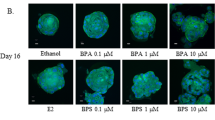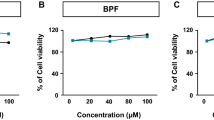Abstract
An endocrine disruptor, bisphenol-A (BPA), has been reported to have several short-term actions in various cells and tissues. However, the mechanisms of these actions have not been fully elucidated. In order to assess the effect of BPA on the intercellular communication mediated by gap junctions, we conducted the present study in the rat epithelium-derived BICR-M1Rk cell-line, in which connexin 43 (Cx43) is a major gap junction channel-forming protein. The cytotoxicity of BPA toward the cultured cells was evaluated by using both MTT reduction and LDH leakage assay systems. The results showed no appreciable loss in cell viability in the presence of increasing concentrations of BPA (from 0.1 to 3.2 μM) for 1 h incubation. However, most of cell viability was lost when cells were incubated for 24 hr with the same concentrations of BPA. The BPA acted as an antagonist on gap junction-mediated intercellular communication (GJIC), and the phenomenon was dose-dependent and irreversible. According to the data obtained from scrape-loading dye-transfer experiments, three quarters of normal GJIC was reduced by concentration of 0.4 μM BPA for 1 h incubation. To identify the relevance of this retardation upon BPA treatment, the GJIC to Cx43 synthesis, the mRNA and protein levels of Cx43 were assessed with RT-PCR and Western-blotting, respectively. The total protein level of Cx43 was almost constant in a wide range of BPA concentrations, as well as in Cx43 mRNA level. These results suggest that BPA inhibits GJIC through a modulation of the gating of gap junction channels, not through a genomic modulation of Cx43.
Similar content being viewed by others
References
Bastiaanse, E. M., Jongsma, H. J., van der Laarse, A., and Takens-Kwak, B. R., Heptanol-induced decrease in cardiac gap junctional conductance is mediated by a decrease in the fluidity of membranous cholesterol-rich domains.J. Membr. Biol., 136, 135–145(1993).
Bennett, S. A. L., Arnold, J. M., Chen, J., Stenger, J., Paul, D. L., and Roberts, D. C. S., Long-term changes in connexin32 gap junction protein and mRNA expression following cocaine self-administration in rats.Eur. J. Neurosci., 11, 3329–3338 (1999).
Bevans, G. C. and Harris, A. L, Direct high affinity modulation of connexin channel activity by cyclic nucleotides.J. Biol. Chem., 274, 3720–3725 (1999)
Cononaco, M., Tavolaro, R., and Maggi, A., Steroid hormones and receptors of the GABAA supramolecular complex. II. Progesterone and estrogen inhibitory effects on the chloride ion channel receptor in different forebrain areas of the female rat.Neuroendocrinology, 57, 974–984 (1993).
Di, W. L., Lachelin, G. C., McGarrigle, H. H., Thomas, N. S., and Becker, D. L., Oestriol and oestradiol increase cell to cell communication and connexin43 protein expression in human myometrium.Mol. Hum. Reprod., 7, 671–679 (2001).
Dodds, E. C., Huang, R. L., Lawson, W., and Robinson, R., Synthetic oestrogenic compounds related to stilbene and diphenylethane. III.Proc. R. Soc. Lond. B. Biol. Sci., 140, 470–497(1953).
Giaume, C., Cordier, J., and Glowinski, J., Endothelins inhibit junctional permeability in cultured mouse astrocytes.Eur. J. Neurosci., 4, 877–881 (1992).
Gigout, S., Louvel, J., and Pumain, R., Effects in vitro and in vivo of a gap junction blocker on epileptiform activities in a genetic model of absence epilepsy.Epilepsy Res., 69, 15–29 (2006).
Goto, K., Fujii, K., Kansui, Y, Abe, I., and lida, M., Critical role of gap junctions in endothelium-dependent hyperpolarization in rat mesenteric arteries.Clin. Exp. Pharmacol. Physiol., 29, 595–602 (2002).
Harris, A. L., Emerging issues of connexin channels: biophysics fills the gap.Q. Rev. Biophys., 34, 325–472 (2001).
Iwase, Y, Fukata, H., and Mori, C., Estrogenic compounds inhibit gap junctional intercellular communication in mouse Leydig TM3 cells.Toxicol. Appl. Pharmacol., 212, 237–246 (2006).
Krishnan, A. V., Stathis, P., Permuth, S. F., Tokes, L., and Feldman, D., Bisphenol A: an estrogenic substance is released from polycarbonate flasks during autoclaving.Endocrinology, 132, 2279–2286 (1993).
Lampe, P. D. and Lau, A. F., Regulation of Gap Junctions by Phosphorylation of Connexins.Arch. Biochem. Biophys., 384, 205–215 (2000).
Lampe, P. D. and Lau, A. F, The effects of connexin phosphorylation on gap junctional communication.Int. J. Biochem. Cell Biol., 36, 1171–1186(2004).
Liu, X. K., Katchman, A., Ebert, S. N., and Woosley, R. L., The antiestrogen tamoxifen blocks the delayed rectifier potassium current, IKr, in rabbit ventricular myocytes.J. Pharmacol. Exp. Ther, 287, 877–883 (1998).
Machala, M., Blaha, L., Lehmler, H. J., Pliskova, M., Majkova, Z., Kapplova, P., Sovadinova, I., Vondracek, J., Malmberg, T, and Robertson, L. W., Toxicity of hydroxylated and quinoid PCB metabolites: inhibition of gap junctional intercellular communication and activation of arcyl hydrocarbon and estrogen receptors in hepatic and mammary cells.Chem. Res. Toxicol., 17, 340–347 (2004).
Markey, C. M., Michaelson, C. L., Veson, E. C, Sonnenschein, C, and Soto, A. M., The mouse uterotrophic assay: a reevaluation of its validity in assessing the estrogenicity of bisphenol A.Environ. Health Perspect, 109, 55–60 (2001).
Mesnil, M., Connexins and cancer.Biol. Cell, 94, 493–500 (2002).
Mohri, T. and Yoshida, S., Estrogen and bisphenol A disrupt spontaneous [Ca2+](i) oscillations in mouse oocytes.Biochem. Biophys. Res. Commun., 326, 166–173 (2005).
Morrissey, R. E., George, J. D., Price, C. J., Tyl, R. W., Marr, M. C, and Kimmel, C. A., The developmental toxicity of bisphenol A in rats and mice,Fundam. Appl. Toxicol., 8, 571–582 (1987).
Nakajima, T., Kitazawa, T, Hamada, E., Hazama, H., Omata, M., and Kurachi, Y, 17 beta-Estradiol inhibits the voltage- dependent L-type Ca2+ currents in aortic smooth muscle cells,Eur. J. Pharmacol., 294, 625–635 (1995).
Pfeiffer, E., Rosenberg, B., Deuschel, S., and Metzler, M., Interference with microtubules and induction of micronuclei in vitro by various bisphenols.Mutat. Res., 390, 21–31 (1997).
Poole, A., van Herwijnen, P., Weideli, H., Thomas, M. C, Ransbotyn, G, and Vance, C, Review of the toxicology, human exposure and safety assessment for bisphenol A diglycidylether (BADGE).Food Addit. Contam., 21, 905–919 (2004).
Quist, A. P., Rhee, S. K., Lin, H., and Lal, R., Physiological role of gap junctional hemichannels. Extracellular calcium- dependent isosmotic volume regulation.J. Cell Biol., 148, 1063–1074(2000).
Reuss, B. and Unsicker, K., Regulation of gap junction communication by growth factors from non-neural cells to astroglia.Glia, 24, 32–38 (1998).
Rouach, N., Tence, M., Glowinski, J., and Giaume, C, Costi- mulation of N-methyl-D-aspartate and muscarinic neuronal receptors modulates gap junctional communication in striatal astrocytes.Proc. Natl. Acad. Sci. U.S.A., 99, 1023–1028 (2002).
Roy, D., Palangat, M., Chen, C. W., Thomas, R. D., Colerangle, J., Atkinson, A., and Yan, Z. J., Biochemical and molecular changes at the cellular level in response to exposure to environmental estrogen-like chemicals,J. Toxicol. Environ. Health, 50, 1–29(1997).
Rozental, R., Srinivas, M., and Spray, D. C, How to close a gap junction channel. Efficacies and potencies of uncoupling agents.Methods Mol. Biol., 154, 447–476 (2001).
Rozental, R., Andrade-Rozental, A. F., Zheng, X., Urban, M., Spray, D. C, and Chiu, F. C, Gap junction-mediated bidirec- tional signaling between human fetal hippocampal neurons and astrocytes.Dev. Neurosci.,23, 420–431 (2001).
Ruehlmann, D. O., Steinert, J. R., Valverde, M. A., Jacob, R., and Mann, G. E., Environmental estrogenic pollutants induce acute vascular relaxation by inhibiting L-type Ca2+ channels in smooth muscle cells.FASEB J., 12, 613–619 (1998).
Saez, J. C, Berthoud, V. M., Branes, M. C., Martinez, A. D., and Beyer, E. C., Plasma membrane channels formed by connexins: their regulation and functions.Physiol. Rev., 83, 1359–1400(2003).
Simon, A. M. and Goodenough, D. A., Diverse functions of vertebrate gap junctions.Trends Cell Biol., 8, 477–483 (1998).
Sohoni, P. and Sumpter, J. P., Several environmental oestrogens are also anti-androgens.J. Endocrinol., 158, 327–339 (1998).
Solomon, I. C, Chon, K. H., and Rodriguez, M. N., Blockade of brain stem gap junctions increases phrenic burst frequency and reduces phrenic burst synchronization in adult rat.J. Neurophysiol., 89, 135–149 (2003).
Tsutsui, T., Tamura, Y, Suzuki, A., Hirose, Y, Kobayashi, M., Nishimura, H., Metzler, M., and Barrett, J. C, Mammalian cell transformation and aneuploidy induced by five bisphenols,Int. J. Cancer, 86, 151–154 (2000).
Verrecchia, F. and Herve, J., Reversible inhibition of gap junctional communication by tamoxifen in cultured cardiac myocytes.Pflugers Arch., 434, 113–116 (1997).
White, R. E., Darkow, D. J., and Lang, J. L, Estrogen relaxes coronary arteries by opening BKCa channels through a cGMP-dependent mechanism.Cir. Res., 77, 936–942 (1995).
Xia, Y and Nawy, S., The gap junction blockers carbenoxolone and 18beta-gylcyrrhetinic acid antagonize cone-driven light responses in the mouse retina.Vis. Neurosci., 20, 429–435 (2003).
Zhang, J. J., Jacob, T J., Valverde, M. A., Hardy, S. P., Mintenig, G. M., Sepulveda, F. V, Gill, D. R., Hyde, S. C, Trezise, A. E., and Higgins, C. F., Tamoxifen blocks chloride channels. A possible mechanism for cataract formation.J. Clin. Invest, 94,1690–1697(1994).
Author information
Authors and Affiliations
Corresponding author
Rights and permissions
About this article
Cite this article
Lee, IK., Rhee, SK. Inhibitory effect of Bisphenol A on gap junctional intercellular communication in an epithelial cell line of rat mammary tissue. Arch Pharm Res 30, 337–343 (2007). https://doi.org/10.1007/BF02977615
Received:
Issue Date:
DOI: https://doi.org/10.1007/BF02977615




